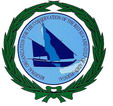
Unintentionally Produced Persistent Organic Pollutants:
Background:
Coastal areas have always been a major focus of development of human civilizations. Many coastal cities and towns worldwide have cultures and ways of life that go back over many centuries. More than half of the world’s population currently live within 60 km of the shoreline – a statistic that could rise to three quarters by 2020. Moreover, 16 of the 20 mega cities of the world are located in coastal areas. Among the numerous threats caused by rapid population growth, development and industrialization in or near coastal areas, is the introduction of Persistent Organic Pollutants.
Persistent Organic Pollutants (POPs) consist of chemicals – pesticides (such as DDT), industrial chemicals (such as polychlorinated biphenyls, PCBs), and unwanted by-products of industrial processes or combustion (such as dioxins and furans) – that are dangerously resistant to environmental degradation. With no or little alterations of their original composition, POPs are transported to oceans and coastal areas by air, water and soil, via direct industrial effluents, sewages and solid source releases, as well as irrational dumping and dredging of waste.
What makes POPs so dangerous is that they are easily transportable and globally pervasive, and t hat they pose serious health risks to all living organisms. POPs bio-accumulate in the fatty deposits of animals and plants and get passed on down the food-chain. They have been linked to alterations in the functioning of hormone systems in fish, wildlife and have been linked to a range of health concerns in humans as well, including cancer, immune-toxicity, thyroid and liver malfunction, nervous system damage, reproductive complications, hormonal disruptions, behavioural problems, allergies, birth defects, and developmental disorders
hat they pose serious health risks to all living organisms. POPs bio-accumulate in the fatty deposits of animals and plants and get passed on down the food-chain. They have been linked to alterations in the functioning of hormone systems in fish, wildlife and have been linked to a range of health concerns in humans as well, including cancer, immune-toxicity, thyroid and liver malfunction, nervous system damage, reproductive complications, hormonal disruptions, behavioural problems, allergies, birth defects, and developmental disorders
The Stockholm Convention on Persistent Organic Pollutants entered into force in 2004 and serves as the primary global, legally-binding, mechanism that calls for international action against the introduction of POPs into the environment. It was signed in Stockholm in May 2001 and entered into force in May 2004.
POPs in the PERSGA Region
The coastal zone of the Red Sea and Gulf of Aden has been witnessing a rapid economic and tourism growth in the last three decades. This is expected to continue in the future. Several coastal investment projects are still in planning in Egypt, Jordan, Saudi Arabia, Sudan and Yemen, mainly in the petroleum and petrochemical industries. This is not to mention the change in the style of life of the new generations by planning new modern cities at the coastal zone. Rapid industrialization will create high pollution rate and hotspots. As a result the use of raw materials, chemicals and energy will increase as well.
Rational of Regional Action
PERSGA has prepared the “Protocol for the Protection of the Marine Environment of the Red Sea and Gulf of Aden from Land-Base Sources (LBS) of Pollution”. The Protocol states that the contracting parties are:
“Committed to the precautionary principle and the ‘polluter pays principle’ and to the use of Environmental Impact Assessments together with the use of the best available technologies and ideal environmental practices, including clean technology production”; “Determined to take the necessary measures in a framework of close cooperation among themselves, to protect the Red Sea and Gulf of Aden from Land-Based sources of pollution”
Article 5, states that the contracting parties shall prevent pollution from LBS, with particular emphasis on the gradual elimination of inputs of toxic, persistent, and bio-accumulating substances by implementation of work plans based on source control.
Article 19, deals with the “adoption of regional measures, work plans and programmes” to best combat pollution and, as such, PERSGA has been working to facilitate translating the written mandates of the protocol into on-the-ground actions.
Establishing a Regional Project
 |
 |
 |
 |
Four of the RSGA countries (Egypt, Jordan, Sudan and Yemen) have ratified Stockholm Convention and concluded in the development of their National Implementation Plans (NIP) that the reduction or elimination of POPs is a respective national priority and that they are committed to take appropriate actions towards the reduction of the releases of unintentionally produced persistent organic pollutants (UP-POPs). Due to the trans-boundary movement of POPs and the special nature of the coastal zone of the Red Sea and Gulf of Aden, it is of importance to take preventive measures to reduce the negative impact of industrial activities and human settlements on the environment of the coastal zone. These preventive measures can be more effective if they are undertaken in a coordinated manner at the regional level. It can be further improved if the regular collection and interpretation of environment related scientific data are also undertaken at the regional level, together with the development of harmonized legislations and interventions. The participating countries have therefore decided to integrate their collective efforts under the regional umbrella of PERSGA and take united actions in reducing UP-POPs releases from selected industrial sources.
The four participating countries have agreed that close cooperation is needed to collectively implement the SC’s measures concerning introduction of best available techniques (BAT) and best environmental practices (BEP) for the coastal zone industries. The countries have further agreed that it could be possible that a larger impact on the environment and the coastal zone economy be attained if the cooperation is made at regional level rather than each country intervenes alone at the industries of its own coastal zone.
UNIDO/GEF Medium Sized Project Against POPs: - Coastal Areas
PERSGA has approached UNIDO in 2006 and both organised a joint workshop on “Regional Promotion of Strategies to Reduce Unintentional Production of POPs in the PERSGA Region”. The purpose of the workshop was to prepare a Project Document with the same title of the workshop. Participants representing PERSGA countries agreed on the importance for each country to produce a report to serve as an inventory of the UP-POPs for the coastal areas, and that the information contained in these reports should be included in the project document to act as a baseline for the project activities. These reports include all the UP-POPs sources and the quantity of their release in the respective countries.
A Medium-Sized Project Document (MSP) was prepared aiming at the development of an action plan and strategy for the elimination of POPs in the RSGA region, in particular the reduction and elimination of the unintentional production of POPs as per Article 5 of the Stockholm Convention (2004); and enabling the introduction and promotion of the use of Best Available Techniques (BAT) and Best Environmental Practice (BEP) to the industrial sector of the coastal zone. Saudi Arabia is in the process of ratifying the Stockholm Convention and has participated in this project but as a self financed country
The objective of the proposed project was to reduce and / or eliminate the unintentional production of POPs (UP-POPs) in key sectors of industry (cement, incineration, metallurgy and pulp and paper) recognized as important source categories in Annex C of Article 5 of the Stockholm Convention through the introduction of BAT/BEP strategies in the industrial sector of the coast in the PERSGA eligible member countries. By achieving this goal, the project will permit PERSGA member countries attain compliance with their obligations under the Stockholm Convention on POPs, particularly those related to the industrial sector releases of UP-POPs. The project will further contribute to the improvement of human health and environmental conditions in the coastal zone as the project is linked to national sustainable development plans of the participating countries.
The proposed project responded to country requests, addressed to GEF through UNIDO and PERSGA, for assistance in meeting regional obligations under Article 5 of the Stockholm Convention concerning the reduction of UP-POPs releases in the PERSGA coastal zones as listed in Annex C of the Stockholm Convention. The countries indicated that the reduction of UP-POPs releases in the selected industries is among the top priorities in their NIPs. Knowing the special situation of the coastal zone, where the majority of the population and industries are present, a strong commitment has been conceptualized by initiating the UP-POPs release reduction measures in the four participating countries.
Project Scenario
The project aimed at implementing the principles of both environmentally and economically sustainable development and critically reviewing trends and lessons to integrate them in regionally coordinated actions. Information on key regional trends, including sources of UP-POPs, vulnerability and impacts of these sources on the environment, human health, socio-economic development and public participation will be made readily available. Region-specific, but nationally connected indicators and their interpretation in forms that are understandable to decision-makers and the public will be clearly highlighted.
The broad participatory nature of the regional strategy for the introduction of BAT and BEP will generate and substantiate on technical lessons and knowledge for further replication in other coastal zone regions. The practical application of the Regional Strategy (RS) will largely contribute to the regional and international discussion on UP-POPs releases and their impacts on coastal zones and a meaningful response will be obtained to make new management change through adaptation of policies and measures.
Since ecological problems connected to POPs would not disappear shortly but increasingly need to be brought to attention through regular reporting procedures, newsletters and web publishing, thus environmental problems are dealt in with more anticipatory rather than reactive way.
BAT and BEP implementation initiatives open new, innovative economic incentives designed for sustainability, which facilitates the private sector to take over the implementation of the BAT and BEP measures from local and regional government authorities. The private sector is more and more engaged in the adaptation and design of new public and private partnerships and cost-sharing arrangements thus public and private interests are better recognized and addressed. Through increased reinvestment at the local-scale, but regionally coordinated, implementation services will strengthen the base for a higher quality of the environment in the coastal zone, increase competitive advantage of this region in tourism and open the possibility for economic diversification.
PERSGA will have the capacity to integrate POPs into its current programme portfolio. Thus coastal zone and its ecosystem, socio-economic development and environmental status will be overseen in a broader way. PERSGA, as a regional entity has the capacity to maximise the effectiveness of the implementation of Annex C related obligations under the Stockholm Convention. PERSGA can effectively direct the countries’ attention to scientifically approve priority areas of action within the region.
While UP-POPs releases continue to pose threats on the environment and public health, the project will build a widespread awareness of the nature of the POPs problem and provides for the possibilities of solutions as well as constraints on mitigation and adaptation of these through the RS.
Project submission review and approval
The project document submitted to GEF in collaboration with UNIDO has been thoroughly followed up and the requirements of GEF have been fulfilled. During the year 2008 GEF has requested organizing a workshop for the stakeholders and other possible funding sources. This was accomplished in collaboration between PERSGA and UNIDO in June 2008. Representatives of the industry, industrial associations and the Islamic Bank of Development participated in the workshop. The project document, along with the workshop’s findings and recommendations have been submitted again to GEF and a final evaluation achieved. The project was fully approved by GEF in October 2008 and actually commenced in March 2009.